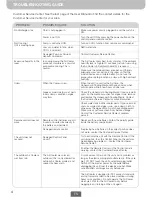
What is Evaporative Cooling?
Honeywell Evaporative Air Coolers are built to maximize energy efficiency and keep energy costs low.
Warm air is drawn into the cooler and enters the Honeycomb Cooling Media. Water pumped from the
water tank pours over the Honeycomb Cooling Media. As the warm air passes through the Honeycomb
Cooling Media, the water absorbs the heat, naturally cooling and humidifying the air. A fan propels the
cooled air out into the room. This no-compressor system cools naturally, efficiently and inexpensively.
Warm and
dry air
Cool and
humid air
Pump
Water
Honeycomb Cooling Media
Evaporative Air Cooling Mechanism
USER TIPS
THANK YOU
Congratulations on your purchase of this versatile Honeywell Evaporative Air Cooler. The Safety &
Maintenance Guide and the separate User Manual are intended to provide you with important
information needed to set up, operate, maintain and troubleshoot this product.
The Evaporative Air Cooler should not be used in enclosed
spaces. It must be kept level and there must be water in the
water tank. Doors and windows should be opened to allow free
air flow. The Evaporative Air Cooler works best when placed near
an open window, so that outside air is drawn into the
Evaporative Air Cooler, circulates in the room, then exits via the
door. The maximum cooling effect is felt when a person is near
the flow of air coming out of the Evaporative Air Cooler. The
Evaporative Air Cooler produces moisture and can be used to
humidify dry air. To be used for humidification the windows and
doors should be closed.
NOTE
When the product is used for the first time the Honeycomb Cooling Media will have an odor which will
dissipate in a few hours or so of initial use.
1
COOLER LOCATION
To maximize efficiency, position the Air Cooler according to the following guidelines:
Indoors
Place the cooler in front of an open door or window. Ensure that there is adequate cross-ventilation in
the room by leaving a door or window open opposite the cooler.
The recommended maximum relative humidity level is 60% or less, which allows a noticeable
temperature decrease. The temperature will be lower in drier climates because higher evaporation
occurs when the humidity is low.
EN




























